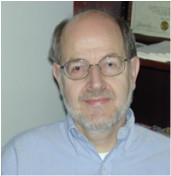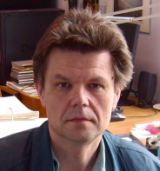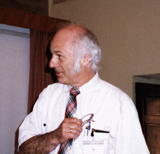Preliminary List of Confirmed Invited Speakers

Ronald G. Douglas, Texas, USA
Title: Canonical models and complex geometry
There are two distinct approaches to the study of contraction operators on a complex Hilbert space in the Cowen-Douglas class, one due to Sz.-Nagy and Foias involving harmonic analysis, and a second due to M. Cowen and the speaker involving complex geometry. Recently, Yun-Su Kim, Hyun Kwon, Jaydeb Sarkar and the speaker undertook a study to compare these two approaches using the language of Hilbert modules.
In this talk, I will describe the framework in which the Hilbert module defining the operator being studied is obtained as a quotient of standard Hilbert modules such as Hardy, Bergmanor weighted Bergman modules on the unit disk. In the context of Sz.-Nagy and Foias, we consider canonical models for which the characteristic operator function is matrix valued having a regular inverse. One shows that the quotient module is in the Cowen-Douglas class and determine the associated vector bundle in terms of the multiplier. This enables one to characterize it in terms of the curvature of the Chern connection and its partial derivatives. These calculations hold not just for quotients built from the Hardy space, but also for weighted Bergman spaces and related spaces.
Title: Canonical models and complex geometry
There are two distinct approaches to the study of contraction operators on a complex Hilbert space in the Cowen-Douglas class, one due to Sz.-Nagy and Foias involving harmonic analysis, and a second due to M. Cowen and the speaker involving complex geometry. Recently, Yun-Su Kim, Hyun Kwon, Jaydeb Sarkar and the speaker undertook a study to compare these two approaches using the language of Hilbert modules.
In this talk, I will describe the framework in which the Hilbert module defining the operator being studied is obtained as a quotient of standard Hilbert modules such as Hardy, Bergmanor weighted Bergman modules on the unit disk. In the context of Sz.-Nagy and Foias, we consider canonical models for which the characteristic operator function is matrix valued having a regular inverse. One shows that the quotient module is in the Cowen-Douglas class and determine the associated vector bundle in terms of the multiplier. This enables one to characterize it in terms of the curvature of the Chern connection and its partial derivatives. These calculations hold not just for quotients built from the Hardy space, but also for weighted Bergman spaces and related spaces.
George C. Hsiao, Delaware, USA

Title: Boundary integral equations recast as pseudodifferential equations
It is known that the treatment of boundary value problems based on variational principles often leads to corresponding boundary integral equations in weak formulations. Their mapping properties can then be derived from those of the associated partial differential equations. However, this approach is restricted only to those boundary value problems which can be formulated in terms of general variational principles based on Garding's inequality. On the other hand, boundary integral equations can also be recast as special classes of pseudodifferential equations. In this lecture, we are concerned with the latter approach by applying pseudodifferential operator theory to a class of elliptic boundary value problems. In particular, the boundary value problems for the Helmholtz equation of scattering theory and the Lamé equations of linear elasticity will serve as model problems for illustrating the basic ideas how one can apply the theory of pseudodifferential operators and their calculus to obtain basic solution properties for the boundary integral equations.
This is a lecture on joint work with Wolfgang L. Wendland [ Hsiao, G.C. and Wendland, W.L.: Boundary Integral Equations,
Springer-Verlang, Berlin, Heidelberg 2008]
It is known that the treatment of boundary value problems based on variational principles often leads to corresponding boundary integral equations in weak formulations. Their mapping properties can then be derived from those of the associated partial differential equations. However, this approach is restricted only to those boundary value problems which can be formulated in terms of general variational principles based on Garding's inequality. On the other hand, boundary integral equations can also be recast as special classes of pseudodifferential equations. In this lecture, we are concerned with the latter approach by applying pseudodifferential operator theory to a class of elliptic boundary value problems. In particular, the boundary value problems for the Helmholtz equation of scattering theory and the Lamé equations of linear elasticity will serve as model problems for illustrating the basic ideas how one can apply the theory of pseudodifferential operators and their calculus to obtain basic solution properties for the boundary integral equations.
This is a lecture on joint work with Wolfgang L. Wendland [ Hsiao, G.C. and Wendland, W.L.: Boundary Integral Equations,
Springer-Verlang, Berlin, Heidelberg 2008]

Félix Ali Mehmeti, Valenciennes, France
Title: The transient tunnel effect and Sommerfeld problem: Waves in semi-infinite structures
Our objective is the analysis of transient waves in two special semi-infinite structures: 1. the wave equation in two space dimensions with zero-Dirichlet-conditions imposed on a half-axis (Sommerfeld problem); 2. the Klein-Gordon equation on a star-shaped network composed of n half-axes connected at their origins, with potentials which are constant but different on each branch.
For 1 we prove the convergence of the resolvent of the spatial part of the problem in an appropriate topology, when approaching the spectrum (a Limiting Absorption Principle). For 2 we analyse the impact of tunnel effect on L-infinity-time-decay. The result is based on a generalized Fourier type inversion formula in terms of an expansion in generalized eigenfunctions and the Hörmander version of the stationary phase formula. The characteristics of the problem are marked by the non-manifold character of the domain. The more developped theory for the tunnel effect on a star-shaped network might serve as a guideline for further studies on transient Sommerfeld type problems.
These two problems can be viewed as examples for a general underlying strategy to analyze the behaviour of complicated compound systems by localization, which often leads to semi-infinite geometries. The price for the obvious advantage that different features of the structure can be isolated from one another, are various mathematical difficulties arising from the semi-infiniteness of domains or boundaries. The talk is based upon joint work with R. Haller-Dintelmann and V. Régnier.
Title: The transient tunnel effect and Sommerfeld problem: Waves in semi-infinite structures
Our objective is the analysis of transient waves in two special semi-infinite structures: 1. the wave equation in two space dimensions with zero-Dirichlet-conditions imposed on a half-axis (Sommerfeld problem); 2. the Klein-Gordon equation on a star-shaped network composed of n half-axes connected at their origins, with potentials which are constant but different on each branch.
For 1 we prove the convergence of the resolvent of the spatial part of the problem in an appropriate topology, when approaching the spectrum (a Limiting Absorption Principle). For 2 we analyse the impact of tunnel effect on L-infinity-time-decay. The result is based on a generalized Fourier type inversion formula in terms of an expansion in generalized eigenfunctions and the Hörmander version of the stationary phase formula. The characteristics of the problem are marked by the non-manifold character of the domain. The more developped theory for the tunnel effect on a star-shaped network might serve as a guideline for further studies on transient Sommerfeld type problems.
These two problems can be viewed as examples for a general underlying strategy to analyze the behaviour of complicated compound systems by localization, which often leads to semi-infinite geometries. The price for the obvious advantage that different features of the structure can be isolated from one another, are various mathematical difficulties arising from the semi-infiniteness of domains or boundaries. The talk is based upon joint work with R. Haller-Dintelmann and V. Régnier.
Wolfgang Wendland, Stuttgart, Germany

Title: On Riesz minimal energy problems
(This is a lecture on joint work with H. Harbrecht, G. Of and N. Zorii)
In the n-dimensional Euclidean space, we study the constructive and numerical solution of minimizing the energy relative to the Riesz kernel of order r-n, where 1<r<n, for the Gauss variational problem, considered for finitely many compact, mutually disjoint, boundaryless (n-1)-dimensional Lipschitz manifolds being charged with Borel measures with prescribed sign. We show that the Gauss variational problem over an affine cone of Borel measures can alternatively be formulated as a minimum problem over an affine cone of surface distributions belonging to the Sobolev-Slobodetski space of order (1-r)/2 on the boundary. This allows the application of simple layer boundary integral operators and, hence, a penalty approximation. A corresponding numerical method is based on the Galerkin-Bubnov discretization with piecewise constant boundary elements. For n=3 and r=2, multipole approximation and in the case 1<r<3=n wavelet matrix compression is applied to sparsify the system matrix. To the discretized problem, a projected gradient method is applied. Numerical results are presented to illustrate the approach.
References
G. Of, W.L. Wendland and N. Zorii: On the numerical solution of minimal energy problems. Complex Variables and Elliptic Equations 55 (2010) 991-1012.
H. Harbrecht, W.L. Wendland and N. Zorii: On Riesz minimal energy problems. Preprint Series Stuttgart Research Centre for Simulation Technology (SRC Sim Tech) Issue No. 2010--80.
(This is a lecture on joint work with H. Harbrecht, G. Of and N. Zorii)
In the n-dimensional Euclidean space, we study the constructive and numerical solution of minimizing the energy relative to the Riesz kernel of order r-n, where 1<r<n, for the Gauss variational problem, considered for finitely many compact, mutually disjoint, boundaryless (n-1)-dimensional Lipschitz manifolds being charged with Borel measures with prescribed sign. We show that the Gauss variational problem over an affine cone of Borel measures can alternatively be formulated as a minimum problem over an affine cone of surface distributions belonging to the Sobolev-Slobodetski space of order (1-r)/2 on the boundary. This allows the application of simple layer boundary integral operators and, hence, a penalty approximation. A corresponding numerical method is based on the Galerkin-Bubnov discretization with piecewise constant boundary elements. For n=3 and r=2, multipole approximation and in the case 1<r<3=n wavelet matrix compression is applied to sparsify the system matrix. To the discretized problem, a projected gradient method is applied. Numerical results are presented to illustrate the approach.
References
G. Of, W.L. Wendland and N. Zorii: On the numerical solution of minimal energy problems. Complex Variables and Elliptic Equations 55 (2010) 991-1012.
H. Harbrecht, W.L. Wendland and N. Zorii: On Riesz minimal energy problems. Preprint Series Stuttgart Research Centre for Simulation Technology (SRC Sim Tech) Issue No. 2010--80.
